Organizational Behavior
Aug 30, 2019 • 544 views
Every company's ultimate goal is to get maximum productivity from its employees so as to get the maximum earnings. For this, it becomes inevitable to satisfy employees not only monetarily but also psychologically and environmentally. But not all employees are the same. Hence, it is important to understand the needs of every individual working for the organisation. And this importance has derived the concept of Organisational Behaviour (OB).
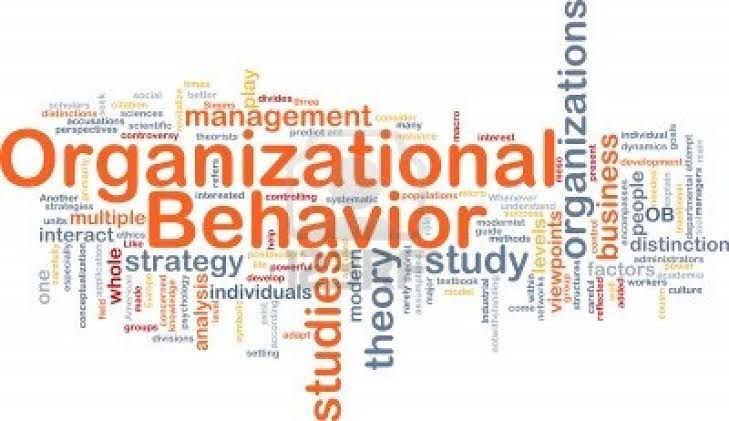
Source:Locus Assignments
Meaning of OB
“Organisational Behavior studies the impact that individuals, groups and structure have on behavior within an organisation for the purpose of applying such knowledge toward improving an organisation's effectiveness.” - Stephen Robbins
In a layman's language, it simply comprises of the study of research dedicated to improving job performance, increasing job satisfaction, promoting innovation and encouraging leadership as mentioned in an article on Investopedia.
For e.g. Online shoe retailer Zappos.com understands how organizational behavior affects an organization’s performance. Zappos maintains good employee relationships by providing generous benefits, extensive customer service training, and a positive, fun-loving work environment. Employees are empowered to make decisions that increase customer satisfaction and are encouraged to create fun and a little weirdness” At Zappos, employee loyalty, job satisfaction, and productivity are high, contributing to the company’s growth. In this photo, employees view a line of shoes in one of the company’s quirky offices.
Importance of OB
Before blindly following anything it is important to know the benefits that we may avail by adopting any new concept. So lets know some of the major benefits of OB through the example of a company named Microsign which comprises of disabled as its 60% of the organisational structure.

Source:GSTTA
Better understanding
This is the most important benefit of OB. OB helps us to identify the reason behind any particular behavior of the individuals within the organisation. As a result, this creates a healthy relationship with everyone in the company. The owner of Microsign , Mr. Nisheeth Mehta in order to have a better communication has learnt the language of deaf and blind. As mentioned by Alison Robbins in a blog only 40% of employees know their company goals.
Better culture
When employees get what they want, it automatically creates a friendly environment in the company. Employees feel motivated and they become dedicated towards the company. This creates a happy culture in the company. Employees of Microsign believes that Microsign has been like a boon for them. They work like a family in the company. The blog by Alison Robbins says, companies with engaged employees make 2.5 times the revenue.
Optimum resource utilisation
When the employees are satisfied, they get highly engaged with the company and its work. And they work towards the betterment of the company because they believe that the company is taking care of its needs. As a result, they work with 100% dedication by which optimum utilisation of the resources takes place. At Microsign, the deaf and dumb are placed at the places of noise because that doesn't really disturbs them; The orthopedically handicapped are placed where least mobility is required and the lunatic is placed at a monotonous job.
Better goodwill
When the company works for the betterment of its company, it simultaneously creates its goodwill in the market. Because consumers tend to choose such companies first that considers its employees like an asset. Microsign is known for its mission “Service above Self”.
Self actualisation
Its an obvious outcome of organisational behavior. OB is for the people, hence, it brings more of training programs, leadership, rewards and recognition. In such a case, employees are bound to feel self actualised. The employees at microsign are happy to work with the company and they want to keep working with them because they believe that it has provided them a home in the form of a living. 87% of highly engaged employees are less likely to leave their company as stated by Alison Robbins in her blog.
Predicting human behaviour
Because OB helps to understand people in a better way, it becomes easier to predict the behaviorof employees in case of any new policy or changes. This helps the company to frame things out accordingly. “Mr. Mehta doesn't make us feel that he is doing a charity to us but shows pride in having us. That's why we are ready to work on Sundays if asked for.” It is clear that OB helps to predict the behavior of the people.
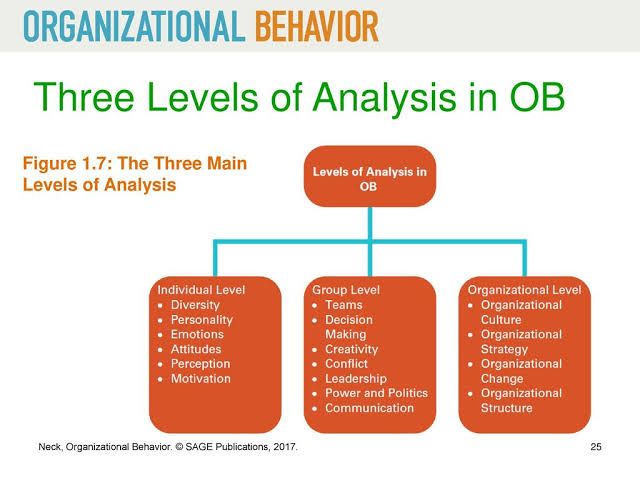
Source:SlidePlayer
Levels of OB
Individual
This level of analysis studies an individual personality, perception, turnover, task performance, cooperative behavior, etc. The reason is that every organisation is at the end an association of individuals. And every individual has his/her own needs and traits. So it is important to understand how individual traits affects the organisation.
For e.g. British entrepreneur Richard Branson, chairman of Virgin Group, is described as energetic, enthusiastic, charismatic, decisive, ambitious, adaptable, courageous, and industrious. These traits helped Branson build one of the most recognized and respected global brands for products and services in the areas of business travel, entertainment, and lifestyle. Identifying personality traits helps organizations select employees and match workers to job.
Group
This level analyses the group behavior. No organisation can work at an individual level. Every organisation are bound to make teams as per the job. So OB studies the behavior of these teams to deliver in a better way. Again, organisations are prone to have informal groups as well. OB also studies their behavior because again directly or indirectly they are going to affect the company as well as the individuals
For e.g. From the Hawthorne Studies, researchers gained valuable insights into how individual behavior is influenced by group norms. They observed that a group of workers determined the level of fair output and established norms for individual work rates that conformed to the output. To enforce the group norms, workers used sarcasm, ridicule, and even physical force to influence individual behaviors that were not acceptable to the group. Researchers also learned that money was less a factor in determining worker output than were group standards, sentiments, and security.
Organisation as a whole
This level studies the organisation as a whole. It studies the culture, structure, technology, change, inter-organisational cooperation and conflict and the external environmental forces.
For e.g. At Sermo, it’s okay for employees to bring their dogs to work and to include them in company meetings, as shown in this photo. Sermo is an online community for physicians where they can collaborate and improve patient care. Sermo’s culture derives from the company’s founder and CEO Dr. Daniel Palestrant, who wants employees to love coming to work, to be comfortable, to have fun, and to just be themselves in a space that suits them. Sermo’s informal work environment and open office plan conveys to employees that the company values openness, individuality, creativity, and flexibility.
Models of OB
OB is the study of the behavior of the people as well as the management. So based on the studies done by numerous scholars, 5 different types of models came into the picture.
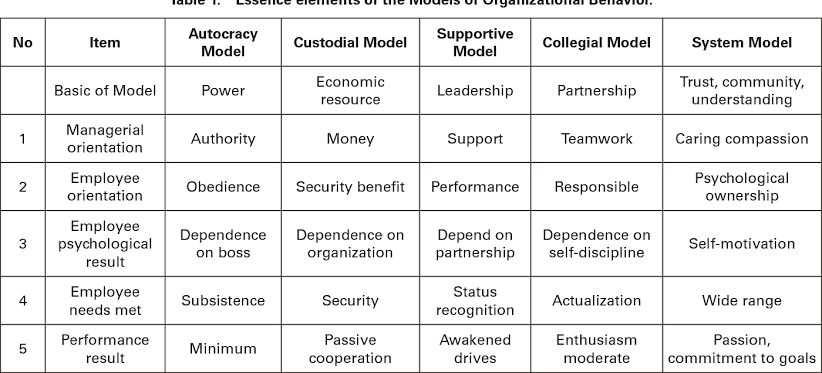
Source:Semantic Scholar
Autocratic
This is a power oriented model where one has the authority to command and the rest have to obey. It believes that thinking has to be done only by the management. This model proved to be successful in situations where employees are lazy. However, this is seen as negative in most of the situations and it is hardly noticed in any organisation. The major drawbacks of this model are frustration, insecurity, dependency on the superiors, minimum performance because of low wages. According to one survey mentioned in an article by Manu Balachandran, 55% of Indians believe that autocracy is very good for governance. However, when it comes to jobs, 75% employees leave job due to their boss, according to a survey.

Source:Encyclopedia Britannica
For e.g. Adolf Hitler was completely an autocratic leader. Because he kept all the decision making to himself and expected the rest to obey his orders.
Custodial
This is security and benefits oriented model where the dependance is on the firm rather than the boss. This model overcame the shortcomings of autocratic model. This model is adopted by the companies having high economic resources. The drawbacks of this model are that employeesare satisfied and happy but not highly motivated. As per a survey, 12% of employees leave company for more money.
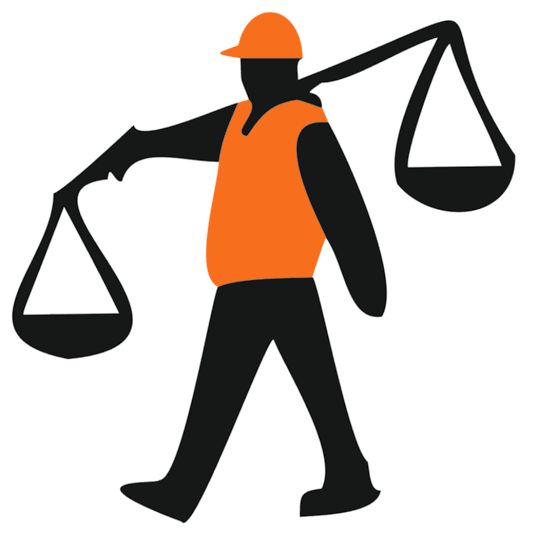
Source:racolb legal
For e.g. All the labourers of any manufacturing plant work for the economic benefits.
Supportive
This is a job performance and participation oriented model. Here, the leadership is with managerial orientation of support. In this model, employees feel a sense of participation becausethey get a climate to grow and accomplish job for the company. Again this overcomes the drawbacks of the previous two models.

Source:Biography
For e.g. Joe Paterno, coach, educator and a humanitarian. He just wanted his team to play good football. He always kept himself available for help, coaching and guidance.
Collegial
This model is oriented towards responsible behavior and self discipline. Employees work for self actualisation. They consider work as an obligation and accepts it as their responsibility as they get the freedom to take decision. Major drawbacks are timely decision, prone to conflucts and disagreements, possibility of unhealthy decision.

Source:Wikipedia
For e.g. Dabur India limited has a culture of employee development, emphasis on pay equity, rewarding stretch efforts and risk taking, cross functional movement of employees and strong emphasis on innovation and learning. All this helped it to build a culture of collegiality.
System
This is most contemporary model of all. It is oriented towards trust and understanding. This model tries to balance the goals of the individual and the organisation. Individuals want remuneration, job security but they also want to work in a positive environment where organisation adds value to the community and the customers.
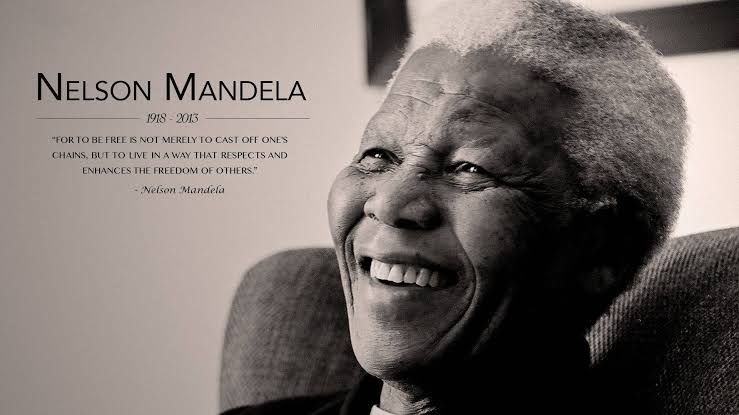
Source:Daily Trust
For e.g. As mentioned in Stanfard Social Innovation Review, Nelson Mandela who undertook interventions aimed at bringing together the remnants of a divided country to face their common challenges collectively and build a new nation.

Source:Norwood
Challenges of OB
Challenges if conquered often brings opportunities for the companies. So let's have a look to some major potential opportunities that can be gained through OB.
Workforce Diversity
Gender, race, ethnicity, relation, community, disability, age, etc. can become a challenging situation for a company to handle. Because no matter how hard one tries, conflicts are bound to occur. As per the study by McKinsey, gender diverse companies perform 15% better and ethnically diverse companies are likely to perform 35% better
Law of diminishing returns
This law states that after certain point of time, increase in desirable practice produce declining returns finally resulting in zero returns followed by negative returns. Similarly, there is an optimum level of desirable practice like recognition or participation. Post that, the desired returns will decline.
For e.g. There was a news published recently where Parle mentioned about its fear of retrenchment of almost 8000-10000 direct & indirect employees because of the demand slowdown. Why did this happen? Because earlier when demand was high, they generated huge returns but because thedemand has slowed down.
Unethical practices
This has become a common situation for every company. The people with the knowledge of OB can use to for their selfish wants ignoring the basic humanity. As per the LRN Ethics Study, 94% of the workers considered it to be criticial or important that the company they work for is ethical.
For e.g. A chemical company releasing pollutants in the air and river is unethical but if the employees blow a whistle against this, they are going to suffer.
Responding to globalisation
Today, majority of the companies are working at a global level. In such a situation it becomes difficult to conduct the OB analysis. Again it becomes difficult to look over the efficiency and the quality of the work done. Inspite of this, Switzerland has been able to top the KOF globalisation index in 2018 with 91.17 points. (Statista)
Innovation and change
This is a highly competitive era where everyday you find something new in the market. In such a situation it is very important to be change adapter and quick learner. However, you cannot expect all your employees to be adaptive. In such case OB becomes difficult to practice. According to McKinsey, 80% of executives think that their current businesses are at risk and 84% believes that innovation is important.
For e.g. Nokia, we all know how tough it had become for it to survive in the android market. Although, it has come back but the market share that it covered earlier has definitely declined.
Emergence of E-Organisation and E-Commerce
Its a digital world and everything has turned out to be digital. Groceries, food, clothes, accessories and other essentials, today everything is available online. Even the taxis are available online. In such a case, businesses who dont turn out on a digital platform definitely is suffering a huge loss. Also the jobs are available online which gives us work from home opportunities. It is expected that 95% of all purchases to be online by 2040 as mentioned in a blog. This makes it difficult for the company to conduct OB analysis.
For e.g. The emergence of Ola and Uber created a huge chaos and rage in the local auto and taxi drivers groups. Because either they had the option to go online or to switch the job.
“An empowered organisation is one in which individuals have the knowledge, skill, desire and opportunity to personally succeed in a way that leads to collective organizational success.” - M Shawn Covey. Thus, in order to succeed as an organisation, first we need to succeed as an employer.
